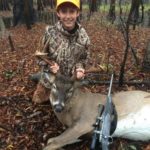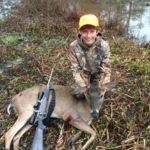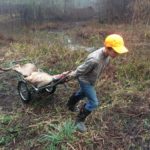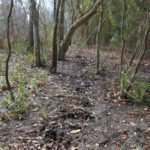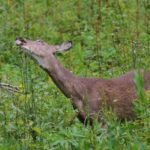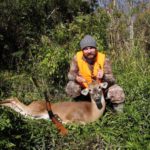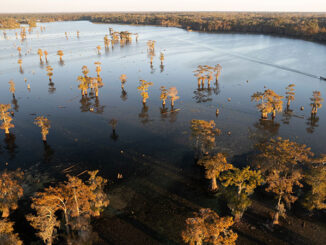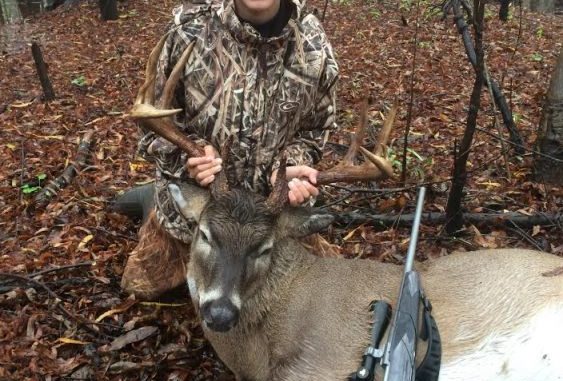
Killing deer in the Atchafalaya Basin is definitely a challenge, but these veteran hunters share their keys to success — both on private and public land.
Jonathan Cheely walked behind his father Jamie in knee-deep water and rain to make an afternoon deer hunt near Bayou Boutte in the Atchafalaya Basin swamp.
Over the past few years, the father-son team had become almost inseparable, as the younger Cheely decidedly became a deer hunter.
Suddenly, Jonathan spotted a deer that had walked out onto a pipeline. It was staring right at them.
What happened next would be the beginning of a Christmas and New Year school break most deer hunters only dream of.
“Look at that deer!” Jonathan said to his father.
“Get your gun ready,” came the older Cheely’s staccato reply.
It’s moments like these when a dozen thoughts go through a hunter’s mind.
Jonathan raised his Ruger Model 77, took aim and squeezed off a shot.
The deer ran off and, like a ghost, disappeared in the swamp.
Initially, Jonathan Cheely’s father thought he had missed the buck he shot at. As it turned out, the buck hadn’t run far — only about 30 yards, in fact.
“I was pretty excited because I saw the antlers and it looked like a pretty big rack, but not that big,” the younger Cheely said. “When we got to him, it was really big.”
The deer turned out to be a huge 10-point — a real Basin buster.
Jonathan Cheely would go on to harvest two more deer during the 2014-2015 season: 6- and 7-point bucks respectively.
Meanwhile, not far as the crow flies, Patterson resident Joe Adydan methodically moved his houseboat up the Atchafalaya River to Attakapas Wildlife Management Area — something he’s done the past seven years.
The primitive weapon season deer hunt on the WMA has become an annual event for him and hunting partner Ferrel DeHart.
Aydan admitted their first year of public-land hunting was a learning experience. He and DeHart didn’t kill a deer, but they still had a good time and had some success — with other species.
“It took us a while to learn where to go: It’s 27,962 acres,” Aydan said. “We went up there with no expectations, not really knowing much about the area.”
An Attakapas WMA veteran helped them out.
“We met up with a guy from Centerville who had hunted Attakapas for years, and he showed us some spots where deer hung out,” Aydan said. “That first year, in our estimation, was a pretty good one. My buddy killed a sow hog and we caught a bunch of catfish.
“Early on it was more about getting away, and sometimes we’d see deer and sometimes we wouldn’t. Now, over the years, we’ve got to where we’ve taken mostly does and some smaller bucks.”
The Basin has its challenges. Hip boots and chest waders are the normal foot attire for negotiating sloughs, bogs and muddy bottoms. Sandbars can be seen during low-water years, but during high-water periods those same ridges will be covered with water.
The Atchafalaya Basin is certainly not for the faint of heart, and those who enjoy consistent success have put in the time to learn the peculiarities of the sprawling swamp.
“Hunting success and participation on Attakapas WMA is highly variable, compared to the majority of WMAs,” Louisiana Department of Wildlife and Fisheries’ Johnathan Bordelon said. “In general, Attakapas WMA does not receive heavy hunting pressure at normal or low water levels when compared to many other WMAs.”
However, it can get crowded if the river remains high.
“River levels and weather conditions play a major role due to the boat-only access,” Bordelon said. “While participation may be less at times, the amount of available habitat must be considered. Higher water levels can concentrate hunters over a smaller area, which does lead to increased pressure — even when the number of efforts is unchanged.”
And thick canopies of tupelo and cypress trees often shade the understory, limiting the growth of some browse deer prefer.
But, as new sandbars form, so do stands of black willow trees, green briar patches and other food resources.
Therefore, not only is it important for hunters to become aware of weather-related flooding pitfalls, they must also learn what deer prefer to eat in that environment.
In flood years like 1973, 2011 and more recently toward the end of the 2015-2016, the Basin deer herd can be really hit hard. So much so that the Louisiana Department of Wildlife and Fisheries sometimes has no choice but to close seasons.
Such was the case last January, when primitive weapon hunting was cut short.
Nonetheless, deer — including some real busters — have been taken from the swamp on both public and private lands.
Shannon Presley’s 175-inch Boone and Crockett buck killed on Attakapas WMA in 1981 still stands as Louisiana’s No. 1 archery deer.
Kevin Breaux scored a 176 5/8-inch St. Mary Parish swamp buck in 2011, and Kevin Brightwell shot a 160 1/8-inch deer in 1996 at Attakapas WMA.
Also, in 2014, Youngsville’s Timothy Trahan shot a buck near Butte LaRose that scored 158 2/8.
Still-hunting challenges on private land
Historically, to be highly successful in the Basin you had to hunt with dogs. The “with or without dogs” deer season in December and January were family affairs for locals who grew up in surrounding towns like Pierre Part, Bell River, Morgan City, Berwick and Patterson.
Much of that’s changed, with private clubs abandoning the dog-hunting tradition.
Bayou Boutte Hunting Club is one of those private clubs in the Atchafalaya Basin swamp that went from dog hunting to still-hunting. Without dogs, knowledge of food sources and scouting for sign became extremely important for these Basin hunters — especially when strategically locating places for permanent box stands.
“We have a few different stands that we hunt,” Cheely said.
Jamie Cheely has been a member of Bayou Boutte Hunting Club for 26 years, and he’ll be the first to tell you that he and his son put their time in the woods looking for various sign like rubs, scrapes and crossings that indicate deer activity and movement.
Besides deer sign around Bayou Boutte, they also look for food sources like briars, willow leaves, acorns, persimmons, dewberries, swamp lily and alligator weed — all keys to being successful.
It’s similar for Aydan on the WMA: Besides solid deer sign like rubs, scrapes and beaten down roads along high ridges, the hunter looks for critical spots to enhance his opportunities.
“You look for pinch points,” Aydan explained. “You look for how much deer have traveled these spots, and you look for rubs.”
But there’s another key feature he searches out.
“I also look for blow-downs — trees that have been knocked down by wind,” Aydan said. “In the bottoms, where you have a lot of water, (blow-downs are) a high spot for deer to yard up on.
“During the day they’ll go back in the swamp for protection, and get up on those blow-downs and just sit out the day. When evening comes, they’ll come out and feed along the high banks. You can actually hear them coming (through) the water sometimes.”
WMA keys
Attakapas, which is still-hunting only, receives the most pressure during either sex weekends.
Hunters participating in the 2014 either-sex hunts on Attakapas experiences one kill per 26 efforts. In 2015, that number dropped to one kill per 18.2 efforts.
In general, the efforts per kill rate continues to fall on all WMAs across the state.
“The late season primitive weapon season was interrupted by the benchmark closure set in motion by the Atchafalaya River high water level last season,” Bordelon said. “WMA hunters were limited to the last two days of the seven-day primitive weapon season, and hunters harvested 15 bucks over those two days.
“Overall, hunter’s harvested 80 deer on Attakapas during the 2015-2016 season, of which 53 were bucks and 27 does.”
Bowhunters killed 29 of that total, he said.
That might not sound like a lot of deer, but Bordelon said the closure has to be considered.
“… (T)he 10-year average for Attakapas WMA is 107 deer,” he explained. “Without those five days of closure due to flooding last season, we were on pace for an average harvest.”
Another advantage of hunting after the holidays in the Atchafalaya Basin, particularly the St. Mary, Lower St. Martin and Iberia parishes part of the Basin, is the later rut that often runs well into late January.
Adydan takes advantage of both the January primitive weapon season (when few hunters are in the woods) and the rut. By scheduling vacation and hunting weekdays accordingly, he increases his chances of killing deer when most of the general public is working.
“I’ll go up on a Sunday afternoon and hunt the whole week — Monday through Friday — and then come out,” he explained.
“It’s quiet and it’s peaceful, with few people around. By that time, most deer hunters are pretty much done for the year, anyway.
“One thing I heard for years was that Attakapas was overrun with hunters and you had to be careful because someone was going to shoot you. … (D)on’t get me wrong, it gets a lot of pressure during the year, but I found it not to be near as bad as what people were saying.”
According to Bordelon, in general, the seasons on Attakapas WMA are shorter than the surrounding non-WMA private land, which lessens some effects of hunting pressure for public-land hunters.
Additionally, there typically are a few weeks between each of the WMA’s firearm seasons, which also lessens hunting pressure.
Whether hunting public or private land in the basin, it takes real effort to discover hotspots containing adequate deer sign, browse and cover.
But, for these Basin busters, it’s all worth the effort.
